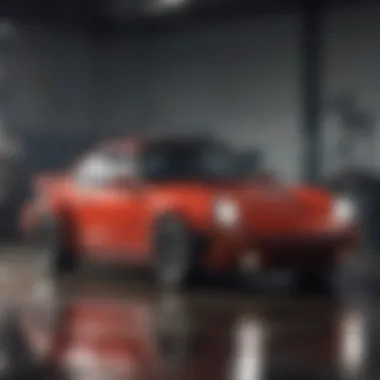Exploring the 1987 Porsche Carrera: Design and Legacy


Intro
The 1987 Porsche Carrera holds a special place in both automotive history and the hearts of enthusiasts. As part of the renowned 911 lineage, it showcases the blend of performance and precision engineering that Porsche is famous for. This model stands out not just for its aesthetics, but also for its remarkable driving experience.
Understanding this vehicle's qualities involves delving into various aspects, including its design philosophy, engineering features, and the marketing strategies employed at the time of release. The analysis of consumer reception provides further insight into the model's impact on the market, which continues to resonate today. Through this exploration, we will also consider comparative studies of the Carrera against its contemporaries to grasp its place in the broader automotive landscape.
Product Quality Evaluations
Methodology for Evaluating Quality
Evaluating the quality of the 1987 Carrera involves several analytical approaches. Primarily, we consider performance metrics, build quality, and consumer satisfaction.
- Performance Metrics: This includes acceleration times, top speed, and handling characteristics. The Carrera's engine, a flat-six, delivers impressive horsepower that translates into exhilarating speed and control.
- Build Quality: Observations of material used in both interior and exterior design are significant. Owners often commend the durability and aesthetic appeal of the materials employed.
- Consumer Satisfaction: Reviews from various automotive publications and user feedback across platforms, such as reddit.com, provide insight into long-term ownership experiences.
Taking these points together allows for a thorough assessment of the Carrera's quality and places it in context with its peers.
Comparison of Different Models
When discussing the 1987 Carrera, comparing it to similar models from its production year is crucial. The main competitors include the Ferrari 328 and the BMW M3. Each model offers unique features that appeal to different segments within the performance car market.
- Ferrari 328: Known for its sleek lines and raw power, the Ferrari emphasizes luxury alongside performance, catering more towards the aristocratic driver.
- BMW M3: This model targets a different audience with its balance of practicality and sporty handling, appealing to those seeking both daily usability and dynamism.
While each of these vehicles has its strengths, the 1987 Porsche Carrera often stands out due to its blend of heritage and performance, creating a legacy that has endured through the years.
Expert Reviews and Recommendations
Comparisons of Similar Models
Expert reviews consistently highlight the strengths and weaknesses of the Carrera in relation to its contemporaries. The Carrera is often praised for its handling and driving dynamics. Some experts note, however, that it may lack in certain technological advancements that were beginning to emerge in other models of the era.
Tips for Buyers
For potential buyers, considering a 1987 Porsche Carrera involves meticulous inspection and research. Here are some critical tips:
- Inspect for Modifications: Many Carrera models have been modified over the years. Checking the extent and quality of these modifications can influence value and performance.
- Service History: A well-documented service history helps ascertain the vehicle’s maintenance and care over time.
- Verify Authenticity: Ensure that the vehicle retains its original parts, as originality often significantly impacts collector value.
In summary, the 1987 Porsche Carrera exemplifies a unique convergence of engineering excellence and market awareness. Its legacy continues to influence not only enthusiasts but also Porsche's subsequent models. Collectors and admirers will find thorough understanding and appreciation for this piece of automotive artistry paramount as they explore its rich history.
Prelims to the Porsche Carrera
The 1987 Porsche Carrera holds a significant place in the automotive narrative, embodying the blend of engineering excellence and iconic design that has distinguished Porsche over the decades. This model marks a noteworthy point in Porsche's evolution, reflecting not only the brand's commitment to performance but also its adaptability in a competitive market. The 1987 Carrera is often recognized for its striking balance between functionality and aesthetic appeal, making it a model of interest for both enthusiasts and collectors.
Historical Context
To appreciate the 1987 Porsche Carrera, one must consider the historical landscape of the 1980s automotive industry. This era was marked by innovation and a shift towards more performance-oriented vehicles. The automotive market was increasingly competitive, with manufacturers seeking to distinguish their offerings through technological advancements. Porsche, a brand with a reputation built on sports cars, understood the need to evolve while maintaining its core identity.
The company had already established a legacy with earlier models, like the 911, which was keenly admired for its distinctive design and superb performance. By the time the 1987 Carrera was launched, Porsche was poised to cater to consumers who craved both style and substance. This model was instrumental in illustrating how Porsche could enhance its lineup while staying faithful to its revered heritage.
Overview of the Porsche Brand
Porsche stands as an emblem of automotive excellence, first founded in 1931. The brand initially offered vehicle development consulting but eventually transitioned into manufacturing its own cars. Over the decades, Porsche has produced various models that continually escalate in both performance and desirability among car enthusiasts.
The 1987 Porsche Carrera is a part of the renowned 911 lineage, a series renowned for its performance, engineering precision, and timeless design. At its core, Porsche's ethos revolves around creating vehicles that deliver powerful performance without compromising comfort or driving experience. The Carrera variant of the 911 is especially known for its engineering prowess and has become a symbol of sports car culture.


"Porsche has always been at the forefront of automotive innovation, consistently updating its models to meet changing consumer expectations."
Throughout its history, Porsche has embraced technological innovation, making strides in both performance metrics and safety features. This commitment is evident in the 1987 Carrera, which features advancements that were cutting-edge for its time. Notably, the vehicle incorporates technologies that enhance both speed and handling, demonstrating Porsche’s dedication to continual improvement in the driving experience.
In summary, understanding the introduction of the 1987 Porsche Carrera not only provides insight into a pivotal vehicle but also reflects the larger narrative of Porsche’s brand evolution during a time of significant change in the automotive world. This perspective is crucial for anyone seeking to grasp the importance and impact of the model in both consumer markets and automotive history.
Design and Aesthetics
Design and aesthetics play a crucial role in defining the character and appeal of the 1987 Porsche Carrera. The design is not merely about looks; it reflects the engineering and performance ethos of the Porsche brand. When one thinks about the 1987 Carrera, they imagine a blend of elegance and sportiness that has become synonymous with Porsche's identity. Understanding the design principles behind this model provides insights into its lasting popularity among automotive enthusiasts.
Exterior Design Features
The exterior of the 1987 Porsche Carrera showcases a sleek silhouette marked by sharp lines and a low profile. The design is both aerodynamic and visually arresting. This model features distinctive round headlights integrated into the body, which adds to its aggressive stance. The front bumper is sculpted to guide air efficiently, enhancing both aesthetics and performance.
Prominent wheel arches accommodate wider tires, providing better road grip and emphasizing the sporty character of the car. The rear of the Carrera is equally impressive, housing a subtly integrated rear spoiler that enhances aerodynamics at high speeds. Moreover, the signature taillights of the era round out its classic look.
In terms of color options, the Carrera offered a range of striking finishes. Classic shades such as Guards Red and Grand Prix White stand out, but more unique colors also made appearances. This range allowed owners to express individuality while maintaining the Porsche heritage.
Interior Layout and Materials
The interior of the 1987 Porsche Carrera is designed with driver engagement in mind. It is not overly luxurious but focuses on functionality combined with subtle elegance. The dashboard layout is driver-centric, with all essential controls positioned within easy reach. This ergonomic design facilitates an immersive driving experience.
Materials used in the interior reflect a commitment to quality. The seats are upholstered in high-grade leather, providing both comfort and support during spirited driving. Additionally, the use of brushed aluminum accents adds a modern touch to the cabin's classic styling.
Space is utilized efficiently, offering adequate legroom and headspace for both driver and passenger. This practicality does not detract from the overall aesthetic; instead, it reveals a thoughtful approach to design.
The combination of a minimalist dashboard, supportive seating, and well-placed instrumentation ensures that drivers feel connected to their vehicle. Owners of the 1987 Carrera appreciate these design choices for enhancing the driving experience while keeping comfort in mind.
"The 1987 Porsche Carrera encapsulates the essence of automotive design—style without excess, form meeting function."
Engineering Specifications
The engineering specifications of the 1987 Porsche Carrera are paramount to understanding its significance within the automotive space. This section will explore key elements like mechanical composition, performance metrics, and drivetrain features that contribute to the car's reputation as an engineering marvel. Knowing these specifications not only provides insight into Porsche's design philosophy but also helps enthusiasts appreciate the model's place in history.
Mechanical Composition
The mechanical composition of the 1987 Porsche Carrera showcases a delicate balance between performance and reliability. At the heart of this model is the 3.2-liter flat-six engine, which presents a substantial output of 207 horsepower and 195 lb-ft of torque. This engine configuration provides a low center of gravity, enhancing handling and stability.
The vehicle features a lightweight body, primarily constructed from steel that is reinforced in critical areas. This choice optimizes strength without unnecessary weight, contributing to the Carrera's agility. The suspension system, which includes front McPherson struts and a rear trailing arm setup, is designed to deliver sharp handling while providing comfort during longer drives.
Moreover, the cooling system employs an oil cooler, which is essential to ensure the engine operates optimally, even under full throttle. This care for technical detail illustrates Porsche's commitment to performance and durability.
Performance Metrics
The 1987 Carrera’s performance metrics are impressive and helped solidify its status in the sports car market. With a 0 to 60 mph acceleration time of just 5.5 seconds, it competed favorably with other contemporaneous models. Its top speed is approximately 150 mph, showcasing its capability on both track and road entertainment.
The car remains steady in both acceleration and braking, thanks to its braking system that includes ventilated discs on all four wheels. This innovation was ahead of its time and important for safety when the car was pushed to limits.
Fuel efficiency is another aspect where the Carrera stands out, achieving around 21 miles per gallon on the highway. This balance makes it practical for daily use yet thrilling enough for weekend drives.
Transmission and Drivetrain
The transmission and drivetrain in the 1987 Carrera represent a keystone of its driving experience. Equipped with a 5-speed manual gearbox, shifting is not just a necessity; it is part of the joy of driving a Porsche. The manual transmission allows for a more engaged driving experience, which is often preferred by enthusiasts.


In terms of drivetrain layout, the Carrera employs a rear-wheel-drive configuration. This setup is pivotal in maintaining the classic sports car dynamic, allowing for a more balanced weight distribution. Such distribution is critical during acceleration and cornering, contributing to an exhilarating driving experience.
Owners often praise the precision of the steering system, which includes rack-and-pinion steering with a quick ratio. This feature allows for responsive handling that enhances the connection between driver and vehicle. Overall, the technical prowess embedded in the 1987 Porsche Carrera's specifications not only serves function but also elevates the model to an icon.
Market Positioning and Reception
The market positioning and reception of the 1987 Porsche Carrera reveal significant insights about its place in automotive history. Understanding these factors is crucial for enthusiasts and industry professionals alike, as it sheds light on how the model was perceived compared to its competitors and its lasting impact on car culture.
Initial Release and Pricing
When the 1987 Porsche Carrera debuted, it entered a competitive segment of sports cars. The base price was approximately $38,000, which positioned it as a premium offering. At this price point, buyers expected not only performance but also quality and prestige associated with the Porsche name. The Carrera was distinctly placed to attract those desiring an exhilarating driving experience without sacrificing everyday usability.
- The car was equipped with a 3.2-liter flat-six engine, generating around 217 horsepower.
- It featured a five-speed manual transmission, a hallmark of Porsche's commitment to driver engagement.
- Early buyers were drawn in by the vehicle's lineage; the 911 nameplate had already established itself as an icon in the industry.
Moreover, the Carrera offered various options that could drive the price higher, such as enhanced audio systems, sunroofs, and specialized wheels. This flexibility allowed Porsche to cater to both the purist and those interested in a more luxurious ride.
Consumer Reception and Reviews
Consumer reception of the 1987 Porsche Carrera was notably positive. Critics praised its balance of power, handling, and everyday usability. The review landscape of the time was infused with excitement for this model, which was often seen as a blend of classic Porsche heritage and modern engineering.
- Automobile Magazine described the Carrera as "the perfect combination of speed and comfort."
- Car and Driver highlighted its "responsive steering and thrilling acceleration."
However, not all feedback was uniformly positive. Some noted that price could be a barrier for many potential buyers, limiting the Carrera's market reach. Additionally, while many found its performance unparalleled, a portion of purists lamented certain modern touches that deviated from the rawness of earlier models.
"The Carrera appeals to a broader audience than many of its competitors. Yet, the die-hard enthusiasts still find reasons to critique."
Comparative Analysis
The comparative analysis serves as a crucial component in understanding the 1987 Porsche Carrera within the larger automotive landscape. By examining its attributes against those of its contemporaries, one appreciates not only the Carrera's strengths and weaknesses but also the market dynamics that shaped its development. Insights drawn from this analysis can inform potential buyers, enthusiasts, and industry scholars alike. This section will focus on two essential aspects: the Carrera's position in relation to its competitors and performance benchmarks against similar sports cars.
Comparison with Competitors
A key aspect of the 1987 Porsche Carrera is its competition at the time. When it was unveiled, the automotive market boasted a range of impressive sports cars. Among these competitors were the BMW M3, the Chevrolet Corvette, and the Nissan 300ZX. Each of these models offered unique characteristics and catered to diverse consumer preferences.
- BMW M3: Known for its agility and precision, the M3 was often regarded as a benchmark for handling. Its lighter body and formidable engine provided drivers with a visceral connection to the road.
- Chevrolet Corvette: The Corvette, with its striking design and powerful V8 engine, appealed to those seeking raw power and straight-line speed. It is often celebrated for its American flair and affordability relative to performance.
- Nissan 300ZX: This car was notable for its technological advancements. Equipped with features like turbocharging and a unique design philosophy, the 300ZX attracted a younger audience.
The Porsche Carrera, with its blend of heritage, performance, and unique styling, positioned itself as a luxury choice among these competitors. While it may not have had the absolute horsepower of the Corvette, it excelled in driving dynamics and build quality, which continued to make it alluring to discerning buyers.
Comparative Performance Studies
When analyzing performance metrics among the top sports cars of the late 1980s, statistics tell a compelling story. The 1987 Porsche Carrera was equipped with a 3.2-liter flat-six engine, allowing it to achieve strong performance figures:
- Horsepower: Approximately 217 hp, which provided thrilling acceleration and responsiveness.
- 0-60 mph: Around 5.5 seconds, competitive for its class, allowing it to hold its own against rivals.
- Top Speed: Reaching nearly 150 mph, the Carrera showcased impressive speed attributes.
Comparing these figures to its main rivals provides additional insight into its standing within the market:
- The BMW M3, while slightly faster in terms of 0-60 time, did not match the Carrera's higher top speed.
- The Chevrolet Corvette outpaced the Carrera in horsepower but might lack the refined handling the Porsche offered.
- The Nissan 300ZX, while technologically advanced, may not have provided the driving engagement felt in the Carrera.
Ultimately, these performance studies not only highlight the Carrera’s capabilities but also its ability to carve a niche in a competitive landscape. The strength of its engineering and its performance-oriented design continues to resonate with enthusiasts today.
"The Porsche 911, especially the 1987 Carrera, is a car that combines everyday usability with track-ready performance, setting a standard for its class that many still aspire to meet."
This comparative analysis, therefore, lays the groundwork for understanding the 1987 Porsche Carrera’s role as a significant player in the automotive world, illustrating its outstanding attributes alongside its less powerful siblings.


Ownership Experience
The ownership experience of the 1987 Porsche Carrera encompasses various elements that significantly affect both the value of the vehicle and the satisfaction of its owner. Understanding these factors is crucial for any potential buyer or current enthusiast. The unique combination of engineering excellence, performance capability, and aesthetic appeal contributes to the allure of this classic model.
Maintenance and Care
Caring for a 1987 Porsche Carrera goes beyond routine servicing. Proper maintenance can significantly influence both the longevity and performance of the car. Here are some key considerations that owners should keep in mind:
- Regular Servicing: It is vital to follow the manufacturer's service schedule. This schedule often outlines necessary oil changes, brake checks, and fluid replacements to ensure optimal performance.
- Use of Genuine Parts: When replacements are needed, using OEM (Original Equipment Manufacturer) parts can help maintain authenticity and performance. Aftermarket parts may not always deliver the same standards.
- Professional Inspections: Having the car periodically inspected by professionals who specialize in vintage Porsches can identify issues before they become serious problems.
- Documentation: Keeping thorough records of repairs and maintenance serves as proof of care and can bolster resale value.
- Protective Measures: Using car covers or garage storage can protect the exterior from environmental factors, such as UV exposure and moisture that may degrade the finish.
Enthusiasts Insights
Insights from enthusiasts provide an invaluable perspective on owning a 1987 Porsche Carrera. Many owners emphasize the communal aspect of ownership, frequently sharing their experiences through forums and social media. Here are some insights:
- Community Engagement: Engaging with clubs and online communities, such as those found on Reddit or specialized Porsche forums, connects owners and potential buyers. Such platforms allow enthusiasts to share tips, tricks, and personal experiences.
- Driving Experience: Owners often highlight the exhilarating driving experience. The balance of speed and control makes the Carrera one of the preferred choices for driving enthusiasts.
- Investment Potential: Many collectors view the 1987 Carrera as an appreciating asset rather than just a car. Its desirability is linked to its performance, historical significance, and aesthetic appeal.
- Customization: Owners often take pride in customizing their Carreras, from aesthetic modifications to performance upgrades. This personal touch enhances the ownership experience and creates a unique vehicle.
Investing time in understanding both maintenance requirements and community resources enhances the value of owning a classic Porsche like the 1987 Carrera.
Legacy and Influence
The legacy of the 1987 Porsche Carrera holds significant weight in automotive history. It is not merely a car; it stands as a benchmark in the evolution of sports cars. Manufacturers and enthusiasts alike recognize the 1987 Carrera for its blend of engineering prowess and characteristic styling. This model introduced a series of design elements and mechanical features that influenced not just subsequent models from Porsche, but also competitors worldwide. Understanding this legacy provides insight into the value and desirability of the Carrera among collectors.
Impact on Subsequent Models
Porsche’s 1987 Carrera set a precedent for future models through a number of innovations. For example, the introduction of enhanced aerodynamics and lightweight materials has been fundamental in the design of later vehicles. The adjustable suspension and power steering system became standard in many of the succeeding models, showcasing a shift toward greater driver control and comfort.
As we look at models like the 911 Turbo and the Boxster, it's clear that many of their features and design cues can be traced back to the foundation laid by the 1987 Carrera. Enthusiasts often speak of this model as a pivotal point for Porsche. It marked a transition from classic styling to a modern aesthetic while upholding performance qualities.
The 1987 Carrera is often seen as a bridge between tradition and innovation in the Porsche lineage.
This influence extends beyond just technical specifications. The model’s success in motorsport has had lasting repercussions on Porsche’s branding and the perception of its vehicles. The racing pedigree it established has carried over to the newer models, reinforcing Porsche’s reputation as a manufacturer of high-performance sports cars.
Cultural Significance
Culturally, the 1987 Porsche Carrera has ingrained itself in popular consciousness as a symbol of speed and luxury. It has appeared in numerous films, television shows, and media, often portrayed as the embodiment of aspiration and success. The model has become a cultural icon, representing not only the technical excellence of Porsche but also the lifestyle associated with luxury cars.
The Carrera's image significantly aligns with themes of performance and exclusivity. Car enthusiasts frequently cite it in discussions about their favorite models, and the vehicles have often been featured in automotive events and exhibitions. This visibility has kept the 1987 Carrera relevant in automotive culture, ensuring its place in conversations about design and performance.
In summary, the 1987 Carrera's legacy is twofold. It not only reshaped Porsche’s approach to design and engineering but also solidified its status as a cultural icon. Understanding this legacy allows enthusiasts and potential buyers to appreciate its significance beyond mere technical attributes, seeing it as a vital piece of the larger automotive narrative.
Finale and Future Prospects
The exploration of the 1987 Porsche Carrera provides significant insights into its design, performance, and lasting impact on the automotive landscape. This model represents a critical bridge between Porsche’s storied past and its innovative future. As we conclude this examination, it is essential to reflect on several key aspects.
One primary focus is the Carrera’s design ethos, which combines elegance with performance. The balance achieved in its aesthetics and functionality continues to inspire modern sports cars. Moreover, its robust engineering laid the groundwork for future models, allowing Porsche to evolve while maintaining a connection to its heritage.
As we look forward, the future prospects of the 1987 Porsche Carrera within the collector's market indicate a growing interest. The vehicle exemplifies qualities that collectors seek: rarity, performance, and historical significance.
"The 1987 Carrera is not just a car; it is a piece of automotive history that resonates with both enthusiasts and collectors alike."
Reflections on the Porsche Carrera
Reflecting on the 1987 Porsche Carrera reveals how it encapsulates the essence of Porsche's brand identity. This model is more than a mere product; it is a testament to engineering excellence and innovative design. The attention to detail in its construction elevates the driving experience while making the vehicle memorable.
Critically, its iconic silhouette and sporty performance remain relevant to discussions of automotive design. A blend of tradition and forward-thinking allows the Carrera to stand apart from its contemporaries. It became an emblem of precision driving, offering pleasure beyond just aesthetic appeal.
Potential for Collectibility
Considering the future, the potential for the 1987 Porsche Carrera as a collectible is promising. Factors contributing to its desirability include limited production numbers, unique engineering features, and a robust enthusiast community. The car holds a significant place among classic sports cars, which tends to increase its market value.
Interest in classic cars continues to grow, with models like the Carrera gaining more attention from collectors and investors. The blend of nostalgia and performance creates a compelling argument for acquisition. Additionally, documented provenance and well-maintained examples are likely to appreciate even further over time.



